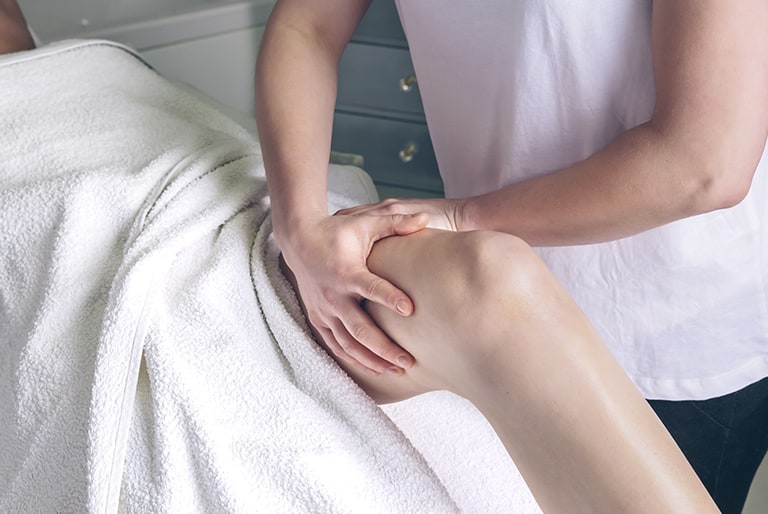Compression therapy
Compression stockings and bandages are usually the main choice for treating vein problems without operating. Here you can find out exactly how compression therapy works and what you should look out for.

How does compression therapy work?
The principle is very simple: the walls of your veins are pressed closer together by the compression. This additional pressure stimulates your blood circulation because your blood can be better pumped upwards from the lower extremities. At the same time, if your venous valves can no longer close sufficiently, the compression prevents reflux and thereby the accumulation of fluids in your legs.
There are several options for creating this external pressure:
- Compression bandage: a phlebological compression bandage is applied after operations for severely swollen legs or for preventing thrombosis. The pressure on the tissue from the bandages stimulates your blood flow. This is because your veins get support from outside from the bandage and can better pump your blood upwards towards your heart. The downside with a compression bandage: it cannot be applied by the patient, only by trained specialists.
- Compressions stockings: the simplest variant is compression stockings, which every vein patient can put on by themselves. Pressure is divided into several compression levels. There are stockings in various lengths for lower leg, thigh or the whole leg, depending on which area particularly needs to be supported. Medical compression stockings should not be confused with support stockings. The latter provide only light pressure which is not enough for therapeutic purposes.
- Intermittent compression: intermittent compression is somewhat more elaborate, as the patient has leg cuffs attached in which air pressure is pumped at short intervals from a compressor. This pressure can be precisely regulated and can be intensified as required. Intermittent compression is predominantly used by patients who are confined to bed and who have difficulty moving.
An important part of compression therapy is always movement: a bandage or stockings on their own do not help a lot if the muscle pump is not activated by leg movement.
When is compression therapy used?
A whole range of venous diseases can be treated with compression therapy.
- Weak veins:(chronic venous insufficiency)
- Varicose veins (varices)
- Water in the legs
- Lymphoedema
- Lipoedema
- Vein thrombosis
- Vein inflammation
- Open leg (Ulcus cruris)
Compression stocking can also be worn as a precaution if spider veins or venous diseases occur in the family. They also serve to prevent thrombosis after operations or on long-haul flights, when there is not enough opportunity to move over a longer period of time. Quite often, compression therapy is combined with other methods of treatment which support blood flow.
Compression therapy should not be used, however, for peripheral artery disease (PAD). Although the symptoms are similar to those of a venous disease, the root cause here is an increasing closure of the arteries, which must be treated differently.
How long each day do you have to wear compression stockings?
Basically, your doctor decides on the length of the therapy with compression stockings. In most vein diseases, like chronic venous insufficiency, the stockings have to be worn as much as possible every day for life, preferably from dawn until dusk. The therapy is usually temporary when treating acute venous ailments or after an operation.
Why shouldn’t you wear compression stockings at night?
Normally, your leg veins do not need support at night, because blood does not collect in your legs at night time and the return flow functions without any problem. In addition to that, your skin also needs a break to breathe. Your skin is allowed to regenerate at night after you have worn the stockings tightly against it during the day.
The exception is a compression therapy after an operation. In this case, it may be necessary to keep the compression stockings on for one to three nights.
Do compression stockings have side effects?
If the compression stockings have been customised, you do not have to fear any side effects. Indeed, it is the opposite: after an initial acclimatisation period the pressure is found to be a pleasant experience. However, badly-fitted or unsuitable stockings can actually cause symptoms such as tingling or pressure pains, which should be clarified with the doctor in charge.
Occasionally, there can be an allergic skin reaction to the material. Dry, flaky skin and itching more frequently occur due to wearing the stockings for long periods. These conditions can be easy cleared with special skin care.
Support your blood flow with Veno SL® 300
Alongside adequate fluid intake, preferably with water or unsweetened tea, you can also support the fluidity of your blood with Veno SL® 300. Troxerutin, the active ingredient which it contains, stabilises your blood vessels if taken regularly and also counteracts the development of oedemas.


